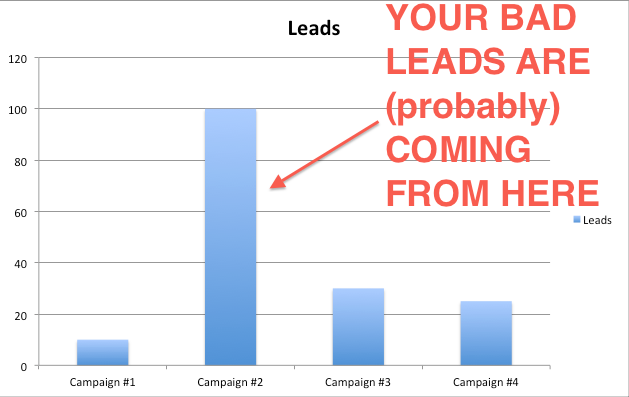3 Tips to Troubleshoot Your Lead Quality

This week on PPC Hero, we’re all about the practical application of PPC know-how to solve major mysteries plaguing your account’s performance. Today, I’m going to share with a you a few pointers on how to troubleshoot where your bad leads may be coming from. With a little bit of time, effort, and ongoing vigilance you can keep your leads squeaky clean with these tips.
1) Have you double-checked your account for the most common offenders of bad leads?
There are a few “bad apple” sources out there that tend to account for more bad leads than others. Being that this is the internet and all, you can get bad leads from just about anywhere – but this is about playing the odds. Here are two sources that have caused us headaches in the past:
- Bing Search Partners: This one is pretty self explanatory, as there are well-documented lead quality issues with Bing’s Search Partner network all over the place. We had a client come to us in the past looking to troubleshoot where all their bad leads were coming from. In an analysis of their bad leads, there was literally a 1:1 correlation with their bad lead total and their Bing Search Partner Conversion total. Oh, and while we’re at it, you should do the same analysis for Google’s Search Partners, too. The solution to this issue was simply opting out of the Bing Search Partner program – it cleaned up their lead quality issues instantaneously.
- Google Display Network: We’ve had a lot of success here on the Display Network with both eCommerce and Lead Generation. However, you *do* have to be vigilant when it comes to lead quality. Case in point: we had a client in the IT industry come to us due to an overabundance of bad leads/bot form submissions. The offending campaign in this case was an innocuous “Content – Mobile” campaign, designed to advertise on mobile devices on the Display Network. While a logically sound idea for a campaign, it was also the highest performer by far, which should clue you in. In this case, the solution involved using Display Network Site Category Exclusions to limit our advertising efforts to high-quality sites only.

2. Look at the most statistically likely sources for your lead quality issues.
This one comes down to pure statistics. Or, y’know, Occam’s Razor. You should check your highest volume campaigns, especially if you’ve got a wealth of bad leads coming in. In our “Content – Mobile” campaign case above, the bad leads were coming from the so-called “best performing” campaign. Here, the simplest answer was the correct one: the campaign responsible for the bad leads was the one that had provided the most.

However, do an analysis of your change history before coming to the above conclusion. Get as much feedback as you can regarding lead quality, and try to pinpoint a date where the problem first presented itself. Look for correlations with those dates and your AdWords/Bing accounts, along with any campaign/targeting changes that may be responsible for the influx of bad traffic. You’ll definitely want to be on the lookout for the following changes:
- Campaigns being launched or reactivated – new campaigns will always need refinement, and old ones may have been paused for a reason.
- Location targets being loosened – consider both “targets searching about” and “targets searching in” when doing this analysis. You might be including a broader geographic reach than you first thought.
- Search partners – yup, mentioning that one again.
- New networks being targeted – Display, Facebook, etc.
- Device targeting – going back to the “Content – Mobile” case, the leads were due to both the Display Network and the mobile device targeting.
You’ll have to do a deep dive in this case – the Dimensions tab (or Bing Report Center) will be your best friend throughout this process. But, there’s another way to help aid your troubleshooting woes:
3. Look for consistent feedback on your lead quality.
Be proactive about troubleshooting your potential lead quality issues. If you (or your client) have a CRM platform in place, use it! If you’ve got URL tracking that can match up your campaigns/keywords with their corresponding leads, it can take a lot of the guesswork out of this process, saving you valuable time in the process.
Really, you should be getting PPC-centric lead-to-sale reports anyway, so asking for a little bit of extra information to weed out poor lead sources should also be on your list of “to-do’s”.
What about you, PPC Heroes and Heroines? Have any other tips and tricks to battle the hordes of bot lead form submissions? What are some common sources of bad leads you’ve discovered? Let us know in the comments and, as always, thanks for reading!



